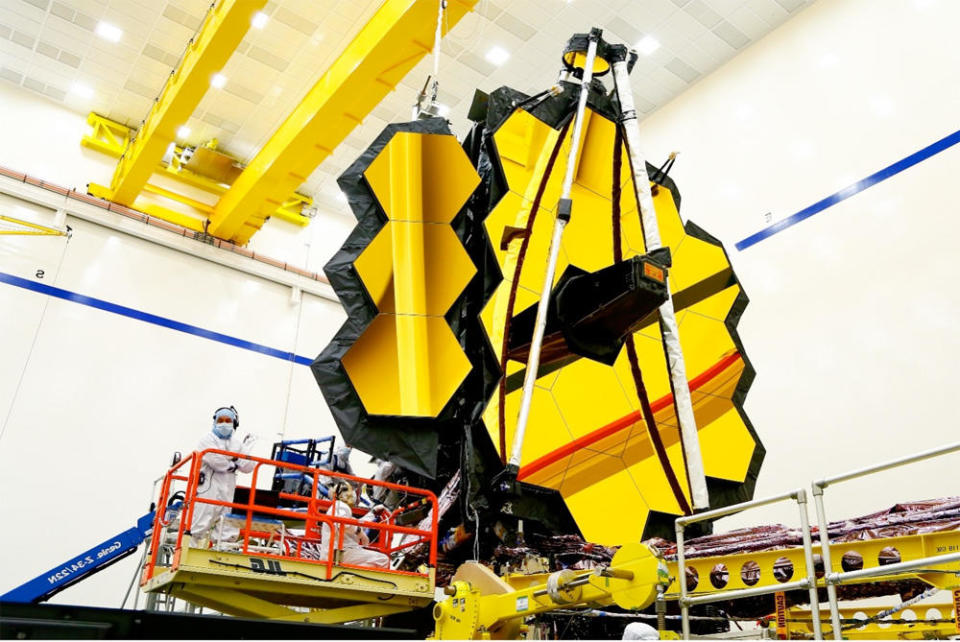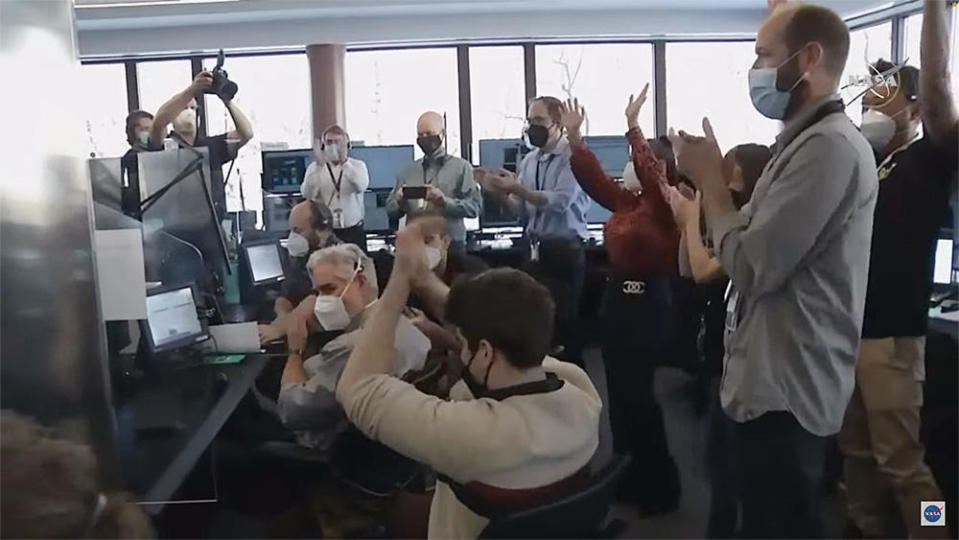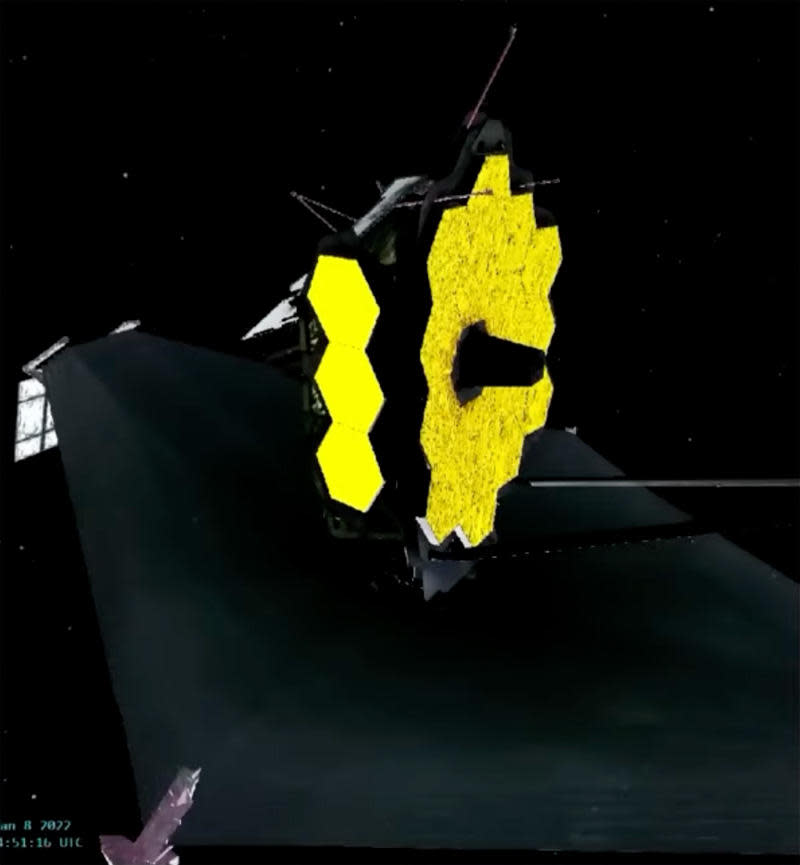"Totally amazing": NASA completes Webb telescope deployments
A pallet holding three of the James Webb Space Telescope's 18 hexagonal mirror segments rotated into position and locked in place Saturday, filling out the observatory's 21.3-foot-wide primary mirror to wrap up the most complicated set of spacecraft deployments ever attempted.
Fourteen days after launch on Christmas Day and now 665,000 miles outbound from Earth, the right-side "wing" of Webb's iconic segmented mirror swung into place at 10:28 a.m. EST, prompting cheers and applause from elated scientists and engineers at the Space Telescope Science Institute in Baltimore.
"We now have a fully deployed telescope," an engineer calmly reported to the team.

Several hours were needed to finish locking the pallet in place, work that was completed just before 2 p.m. The latching marked the conclusion of the riskiest, most complex set of steps ever attempted to essentially unfold the largest, most powerful telescope ever launched.
Given the need to successfully unfurl Webb's fragile, tennis court-size sunshade, and the precision required for unfolding its optical components, radiators and other critical gear, "this has been arguably the most challenging deployment program ever done by NASA," said systems engineer Mike Menzel.
Mission managers were thrilled with the results.
"I just want to thank everyone, congratulate them on a safe mirror move," project manager Bill Ochs told the operations team. "The last two weeks have been totally amazing. Thousands of people have worked on JWST to this point to get us here. ... Every single day, I am honored and humbled to be associated with this team."

At a cost of nearly $10 billion, Webb is the most expensive science spacecraft ever built and by far the most powerful space telescope, 100 times more sensitive than the 31-year-old Hubble, the observatory it will eventually replace.
It's also one of the most challenging to deploy, with success riding on the flawless operation of 178 release mechanisms that all had to work perfectly to carry out 50 major deployments to unfold the telescope after it was packed into the nose cone of a European Space Agency-supplied Ariane 5 rocket.
Bound for an orbit around the sun a million miles from Earth, Webb already is far beyond the reach of any foreseeable astronaut repair crews. Its complex, multi-step metamorphosis, requiring all those non-redundant mechanisms to work exactly as planned, simply had to work.
And it did.
"I'm emotional about it," said NASA science chief Thomas Zurbuchen. "What an amazing milestone. One hundred seventy-eight out of 178 of these actuators that had to fire the right way, I'm just so amazed and in awe of this team."
Next up for Webb, now that its structural deployments are complete: precisely aligning the 18 segments of its primary mirror to achieve razor-sharp focus. At the same time, its science instruments must be checked out and calibrated, all the while waiting for the telescope to cool down to near absolute zero.
The first science images are expected in about six months.
"We start with the mirrors off by millimeters, and we're driving them to be aligned within less than the size of a coronavirus, like to tens of nanometers," said Jane Rigby, Webb operations project scientist. "It's this very deliberate process that is time consuming."
Rather than showing off initially blurry "first light" images in the next few weeks, "we want to make sure that the first images that the world sees ... do justice to this $10 billion telescope," she said. "So we are planning a series of 'wow' images to be released at the end of commissioning."
Since its December 25 launch, Webb successfully unfolded its critical solar array, the high-gain antenna it will use to beam data back to Earth, a stabilizing "momentum flap" to counteract the effects of the solar wind and radiators to dissipate excess heat.
But radiators alone were not enough.
Webb was designed to capture light from the first stars and galaxies to form after the Big Bang, radiation that has been stretched into the infrared region of the spectrum by the expansion of space itself over the past 13.8 billion years.
To register that faint heat, Webb must be cooled to within 50 degrees of absolute zero, or down to around 370 degrees below zero Fahrenheit.


In the riskiest deployment procedure of all, two pallets unfolded and five hair-thin Kapton layers were pulled out to form a sunshade the size of a tennis court using 90 motor-driven cables running through scores of pulleys.
As the layers were slowly pulled taut, they were lifted and separated to provide a gap between each one, allowing heat to reflect out the sides. While the layer facing the sun will experience temperatures as high as 290 degrees, the telescope will be cooled to unprecedented levels to register infrared light from the first galaxies.
Midway through the sunshade's deployment, a tower was extended, elevating the primary mirror and instruments 4 feet above the shield to provide clearance for membrane tensioning and to further distance the optics from the heat generated by the spacecraft's electronic gear.
With sunshade deployment complete, engineers sent commands to unfold Webb's 2.4-foot-wide secondary mirror atop an articulating tripod made up of three 25-foot-long booms. An instrument radiator then was deployed to help dissipate heat generated by Webb's science instruments.
That set the stage for the final two deployments in the telescope's initial commissioning.
Webb's segmented primary mirror was too large to fit inside any existing rocket's nose cone. So six of its 18 segments, three on each side, were folded back out of the way on hinged pallets. The left-side pallet was rotated into position Friday and the right-side pallet followed suit Saturday.
"This is a huge milestone to complete all of the deployments," said Greg Robinson, the Webb mission director. "We still have a long ways to go, but certainly its great to have this part behind us."
With the deployments complete, flight controllers now will begin work to precisely align all 18 segments so they act as a single 21.3-foot-wide mirror.

Each segment features six mechanical actuators allowing movement in six directions. A seventh actuator can push or pull on the center of a segment to ever so slightly distort its shape if needed.
Before alignment, the 18 segments will produce 18 separate images. Using Webb's infrared camera, engineers will map the alignment of each segment and send commands to adjust the orientation and curvature as required to produce a single, sharply-focused image. The process is expected to last several months.
"This telescope is not ready out of the box," Rigby said. "The first images are going to be ugly. It's going to be blurry, 18 of these little images all over the sky. ... It's like we have 18 mirrors that are right now little prima donnas, all doing their own thing ... and we have to make them work like a chorus. That is a methodical, laborious process."
But at the end of commissioning in about six months, images will be unveiled "that are designed to showcase what this telescope can do and ... really knock everybody's socks off."
Webb was designed to operate for five to 10 years, a lifetime based on how much on-board propellant is available for maintaining the telescope's orientation. But thanks to the accuracy of its launch and two subsequent trajectory correction maneuvers, Menzel said it should be able to operate for roughly 20 years.
Space heater blamed for starting Bronx fire that killed 19, including nine children
American Girl introduces Chinese-American doll as its "Girl of the Year"

